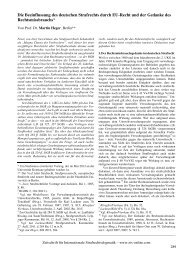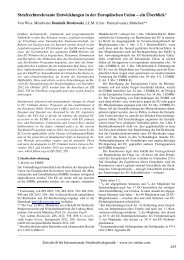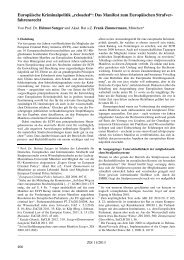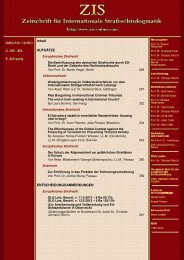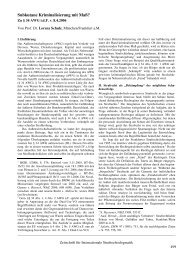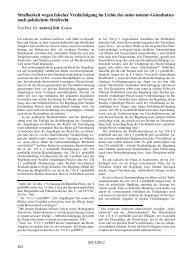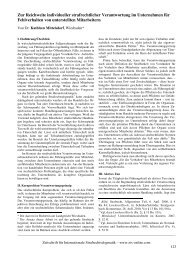Inhalt AUFSÄTZE ANHANG - ZIS
Inhalt AUFSÄTZE ANHANG - ZIS
Inhalt AUFSÄTZE ANHANG - ZIS
- No tags were found...
Create successful ePaper yourself
Turn your PDF publications into a flip-book with our unique Google optimized e-Paper software.
Kai Ambos_____________________________________________________________________________________derogable rights recognized by international human rightslaw. […] The Court, in accordance with the arguments putforward by the Commission and not contested by the State,considers that the amnesty laws adopted by Peru preventedthe victims’ next of kin and the surviving victims in this casefrom being heard by a judge, as established in Article 8 (1) ofthe Convention; they violated the right to judicial protectionembodied in Article 25 of the Convention; they prevented theinvestigation, capture, prosecution and conviction of thoseresponsible for the events that occurred in Barrios Altos, thusfailing to comply with Article 1 (1) of the Convention, andthey obstructed clarification of the facts of this case. Finally,the adoption of self-amnesty laws that are incompatible withthe Convention meant that Peru failed to comply with theobligation to adapt internal legislation that is embodied inArticle 2 of the Convention.“ 47Bezüglich der Rechtsfolgen der damit erfolgten Unwirksamkeitserklärungder peruanischen Selbstamnestie stellte derIAGMR klar:„[…] Owing to the manifest incompatibility of selfamnestylaws and the American Convention on HumanRights, the said laws lack legal effect and may not continueto obstruct the investigation of the grounds on which this caseis based or the identification and punishment of those responsible,nor can they have the same or a similar impact withregard to other cases that have occurred in Peru, where therights established in the American Convention have beenviolated.“ 48Am 29. November 2006 – parallel zum peruanisch-chilenischenAuslieferungsverfahren gegen Fujimori (dazu sogleichIII.) – verurteilte der IAGMR den peruanischen Staat im FallLa Cantuta für die von der Gruppe Colina begangenen Entführungenund Tötungen. Das Gericht stellte fest, dass Colina:„[…] was a group related to the Servicio de InteligenciaNacional (National Intelligence Service) whose operationswere known by the President of the Republic and the CommanderGeneral of the Army. It had a hierarchical structureand its personnel received, besides their compensations asofficials and sub-officials of the Army, money to cover theiroperative expenses and personal pecuniary compensationsunder the form of bonuses. The Colina Group carried out aState policy consisting in the identification, control and eliminationof those persons suspected of belonging to insurgentgroups or who opposed to the government of former PresidentAlberto Fujimori. It operated through the implementationof systematic indiscriminate extra-legal executions, selectivekillings, forced disappearances and tortures.“ 4947 IAGMR, Case of Barrios Altos v. Peru. Merits. JudgmentMarch 14, 2001. Series C No. 75, para. 41-42; siehe auchIAGMR, Case of La Cantuta v. Peru. Merits, Reparations andCosts. Judgment of November 29, 2006. Series C No. 162,para. 152. Zur Völkerrechtswidrigkeit solcher Selbstamnestienmit besonderer Berücksichtigung der südamerikanischens. schon Ambos (Fn. 28) S. 236 ff.48 IAGMR, Barrios Altos (Fn. 47), para. 44.49 IAGMR, La Cantuta (Fn. 47), para. 80 (18).Außerdem leitete der IAGMR aus Art. 8 Abs. 1 und 25i.V.m. Art. 1 Abs. 1 AMRK eine völkerrechtliche Pflicht zurzwischenstaatlichen Kooperation bei der Strafverfolgung undAuslieferung wegen schwerer Menschenrechtsverletzungenab. 50 Nach Ansicht des Gerichts führt die Notwendigkeit,Straflosigkeit für systematische Menschenrechtsverletzungenzu verhindern, zu Kooperationspflichten innerhalb der internationalenStaatengemeinschaft; das Recht auf effektivengerichtlichen Rechtsschutz („access to justice“) impliziereeine erga omnes-Pflicht der Staaten, alle notwendigen Maßnahmenzur (eigenen) Aburteilung oder Auslieferung (autdedere aut judicare) 51 der Verantwortlichen zu ergreifen. 52 ImHinblick auf das Verhältnis zwischen einer Wahrheitskommissionund normaler staatlicher Strafverfolgung hat derIAGMR schließlich im September 2006 im Fall AlmonacidArellano entschieden, dass jene diese nicht ersetzen könne. 53IV. Das Auslieferungsverfahren gegen FujimoriNach Fujimoris Ankunft in Japan im November 2000 ersuchtePeru um seine Auslieferung; dies wurde von Japan unterVerweis auf Fujimoris japanische Staatsangehörigkeit abge-50 IAGMR, La Cantuta (Fn. 47), para. 158-160.51 Zu diesem Prinzip statt vieler Bassiouni/Wise, Aut DedereAut Judicare, The Duty to Extradite or Prosecute in InternationalLaw, 1995.52 IAGMR, La Cantuta (Fn. 47), para. 160: „As pointed outrepeatedly, the acts involved in the instant case have violatedperemptory norms of international law (jus cogens). UnderArticle 1(1) of the American Convention, the States have theduty to investigate human rights violations and to prosecuteand punish those responsible. In view of the nature and seriousnessof the events, all the more since the context of thiscase is one of systematic violation of human rights, the needto eradicate impunity reveals itself to the international communityas a duty of cooperation among states for such purpose.Access to justice constitutes a peremptory norm of InternationalLaw and, as such, it gives rise to the States’ ergaomnes obligation to adopt all such measures as are necessaryto prevent such violations from going unpunished, whetherexercising their judicial power to apply their domestic lawand International Law to judge and eventually punish thoseresponsible for such events, or collaborating with other Statesaiming in that direction. The Court points out that, under thecollective guarantee mechanism set out in the AmericanConvention, and the regional and universal internationalobligations in this regard, the States Parties to the Conventionmust collaborate with one another towards that end.“53 IAGMR, Case of Almonacid-Arellano et al. v. Chile. PreliminaryObjections, Merits, Reparations and Costs. Judgmentof September 26, 2006. Series C No. 154, para. 150.Zum komplexen Verhältnis zwischen Wahrheitskommissionenund normaler Strafverfolgung s. auch Ambos, The legalframework of transitional justice: A systematic study with aspecial focus on the role of the ICC, in: Ders./Large/Wierda(Hrsg.), Building a future on peace and justice: studies ontransitional justice, peace and development, 2009, S. 19 (S. 43f., para. 14)._____________________________________________________________________________________556<strong>ZIS</strong> 11/2009




